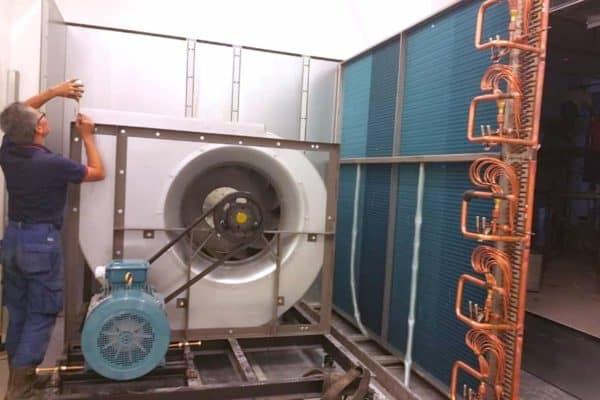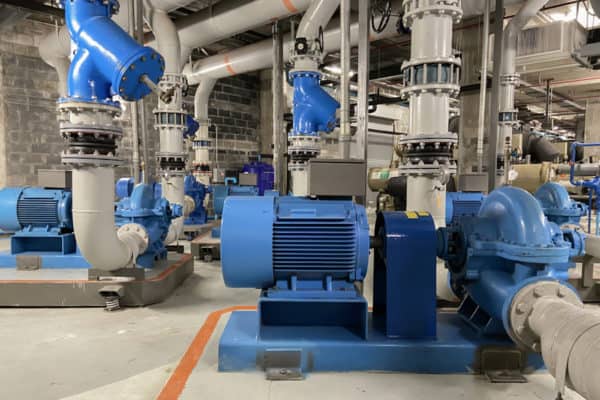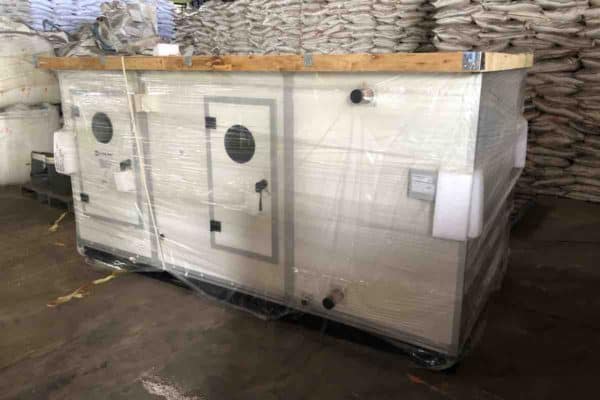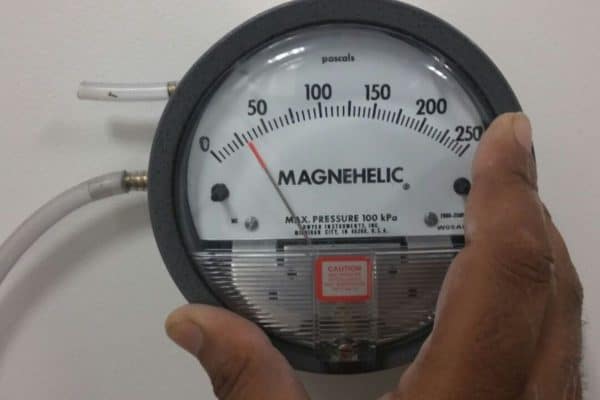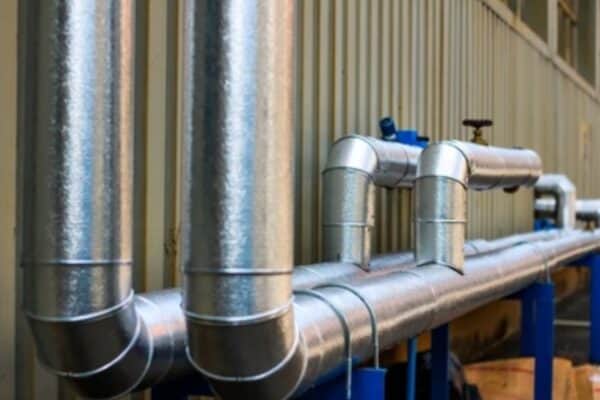Do UV Lights in HVAC Work? (Check These Parameters)
Many people wish to improve the indoor air quality of their homes by installing UV lights in their HVAC systems. However, most people have little to no information about the correct application of UV lights in HVAC. So, I spoke to two UV light experts to find out more about UV light application in HVAC.
UV lights effectively prevent microorganisms such as bacteria, viruses and fungus from growing on the evaporator coil of air handling units and therefore, reduce air pressure drop, increase heat transfer coefficient and reduce the energy consumption of the HVAC system.
Although UV lights in HVAC do work, adequate UV intensity and exposure time are required to achieve an effective microorganisms kill rate.
Is It True that UV Lights Kill Mold and Bacteria?
Based on my conversation with UV light experts and my research on UV radiation, it is confirmed that UV light indeed is a proven method to kill microorganisms such as bacteria, viruses and fungus including mold.
“UV light is a proven method to kill microorganisms.”
The “C” band of ultraviolet light (UVC) disrupts the ongoing reproduction cycle of microorganisms such as bacteria, viruses, mold and fungus. It prevents further growth of microorganisms and hence, killing them permanently.
Short wave ultraviolet radiation in the “C” band (UVC) that has wavelengths of 200 to 280 nanometers was found to be the most effective germicidal irradiation wavelengths nearly 100 years ago. Specifically, at 253.7 nanometers, the UVC light is most optimum to inactivate microorganisms such as bacteria, viruses and fungus.
However, I understand that adequate intensity of UV light is required to achieve an effective kill rate.
Thus, companies who sell and implement UV lights in HVAC systems are required to perform tests and obtain certifications thereby confirm that their UV lamps can maintain enough intensity under certain conditions for a prolonged period of time and therefore, are appropriate to kill microorganisms.
If a UV lamp is not tested and certified, we don’t know how effective it is. Furthermore, the test method is important because the UV lamp must be designed to work under cold and damp conditions since it is installed inside the duct or the air handling unit of HVAC systems.
How Much UVC Light is Required?
There are many different kinds of microorganisms that live in air conditioning systems. Some are dangerous, some are harmless to humans. In the Ultraviolet Germicidal Irradiation Handbook by W. Kowalski, the UV dosage required to kill microorganisms is recorded.
Following are some of the common microorganisms that are harmful to humans and the respective UV dosage to kill them:
| Microorganism | Type | Dosage, D90 (μJ/cm2) |
|---|---|---|
| Aspergillus Flavus | Mold | 60,000 |
| Aspergillus Niger | Mold | 132,000 |
| Streptococcus Pneumoniae | Bacteria | 46,800 |
| Streptococcus Pyogenes | Bacteria | 400 |
| Haemophilus Influenzae | Bacteria | 3,800 |
| Mycoplasma Pneumoniae | Bacteria | 800 |
| Pseudomonas Aeruginosa | Bacteria | 17,200 |
| Serratia Marcescens | Bacteria | 2,400 |
| Staphylococcus Aureus | Bacteria | 26,000 |
Data in the above table are extracted from multiple sources, mainly as below:
- Microorganisms found in air conditioning systems [source].
- Bacteria that cause allergy reactions [source].
- UV dosage requirement for different microorganisms [source].
A more complete list of microorganisms including bacteria, viruses and fungal can be found in the appendices of W. Kowalski, Ultraviolet Germicidal Irradiation Handbook [download].
As you can see from the above table, UV lights in HVAC must have sufficient dosage in order to kill these harmful microorganisms. UV dosage is depending on the intensity of the UV radiation emitted from the UV lamp and the exposure time of the microorganisms to the UV radiation.
Dosage, D90 is the product of UV intensity and exposure time. At D90, 90% of a particular microorganism is inactivated. A higher dosage is required to achieve a 99.99% kill rate (log 4 reduction).
Log reductions:
- Log 1 reduction = 90% (D90)
- Log 2 reduction = 99%
- Log 3 reduction = 99.9%
- Log 4 reduction = 99.99%
Factors that Affect UVC Lamps Performance
Sufficient UV dosage is required to kill microorganisms. UV dosage is calculated based on the following formula:

Irradiation is also known as intensity.
Every UV lamp should have an intensity rated at a certain distance under certain working conditions. For instance, a UVC lamp may produce 100 μW/cm2 at 1 meter distance at a temperature of 60°F (15.5°C) at an airflow rate of 500 fpm (2.54 m/s).
As a result, we know that UV dosage is affected by the following elements:
- How strong is the UV light emitted from the lamp? (intensity or irradiation)
- What’s the distance between a surface and the UV lamp? (long distance, less intensity)
- What’s the UV lamp surrounding temperature? (affects intensity)
- How long is a microorganism exposed to the UV radiation? (exposure time)
- What’s the airflow rate? (fast airflow, less exposure time)
Without knowing the intensity or the irradiation of the UVC lamps, we don’t know how many UVC lamps should be installed at a given exposure time and working conditions in order to kill harmful microorganisms effectively.
If UVC lamps are going to be placed after the cooling coil, which is the most effective location, the exposure time is essentially infinite. In this case, we may not need to know the UV lamp’s intensity. However, we can’t optimize power consumption since we don’t know how long we should let the UV light stay on.
Similarly, if we are going to put UVC lamps in-duct or inside a return air duct, we need to know the intensity of the UVC lamps because the exposure time is so little and more UVC lamps are required to achieve an effective kill rate.
Measuring the Intensity of UVC Light
The intensity of UVC lights can be measured by using a UVC Light Test Card (Amazon affiliate link) which indicates whether the intensity level is above or below 300 μW/cm2 only. Alternatively, a Digital UVC Meter (Amazon affiliate link) can be used to measure the exact intensity level.
UVC lamps generally perform the best when their lamp wall temperature is around 104°F (40°C). Increasing and decreasing the lamp wall temperature will reduce the UVC intensity as well as the total lifetime of the lamps [source].
Hence, UVC intensity measurement must be done under actual or close to actual operating conditions. For example, a UVC lamp with 200 μW/cm2 of intensity at room temperature may drop to 100 μW/cm2 when placed inside an operating air handling unit.
UVC light intensity is also affected by the distance between the UVC lamps and the measuring device. The further the distance, the lesser the intensity (exponentially). The same applies to you when installing UVC lamps in a furnace or an air handling unit.
Estimating the Performance of UVC Lamps
Many UVC lamps in the market only have a wattage rating; their UVC intensity is not published. High wattage doesn’t translate to high intensity. Sometimes, high-wattage UVC lamps are just not efficient.
For instance, two different models of Philip UVC lamps with 18W, at a 300mm distance, one has a UVC intensity of 344 μW/cm2 and the other has 577 μW/cm2 of UVC intensity.
Using Philips’s surface disinfection tool, we can get the intensity of their UV lamps. Hence, I tabulated the below table for us to estimate the UVC intensity of other UVC lamps:
| Philips UVC Lamps | Power | UVC Intensity at 300mm |
|---|---|---|
| TUV T8 F17 1SL/25 | 18W | 344 μW/cm2 |
| TUV PL-L 18W/4P 1CT/25 | 18W | 577 μW/cm2 |
| TUV 36W SLV/6 | 36W | 657 μW/cm2 |
| TUV PL-L 36W/4P 1CT/25 | 36W | 952 μW/cm2 |
| TUV 64T5 HO 45 SE UNP/32 | 145W | 1499 μW/cm2 |
If you ask me, I would guess that UVC lamps in the market generally have an intensity as below:
- 18W = 300 μW/cm2 at 300mm distance
- 36W = 600 μW/cm2 at 300mm distance
- 144W = 1200 μW/cm2 at 300mm distance
I use more conservative numbers since Philips UVC lamps are branded and we don’t know how other UVC lamps perform under low-temperature conditions.
How Long Should UVC Lamps Stay On?
By knowing the UVC light intensity, we can calculate how long it takes for a particular UVC lamp to kill microorganisms at different rates (eg: 90%, 99%, 99,9%, 99.99%…).
Following is a log reduction graph that we can use to estimate the required exposure time:

Let say we use a Philips UVC lamp (TUV 64T5 HO 45 SE UNP/32) with 145W in an HVAC system. When placed after the cooling coil at a 300mm distance, the lamp shines 1499 μW/cm2 of UVC light on the cooling coil.
Take the toughest microorganism in the earlier table which is the Aspergillus Niger, we need 132,000 μJ/cm2 of UVC dosage to kill 90% of it. That translates to an exposure time of 88 seconds or about 1.5 minutes.
To achieve log 2 reduction (99%), simply double the exposure time to 176 seconds or about 3 minutes. To achieve log 4 reduction (99.99%), double the exposure time again to 352 seconds or about 6 minutes.
Needless to say, the higher the intensity, the shorter the exposure time. In another word, the higher the wattage, the shorter the exposure time (most of the time). Doubling the UVC lamps also shorten the exposure time by half.
However, you should give about 30% more exposure time than the calculated exposure time because the same UVC lamp only produces 1098 μW/cm2 of UVC light at 400mm distance which may be the distance from the corner of the cooling coil to the UVC lamps 300mm away from the center of the cooling coil.
If you have limited space in the HVAC unit, you may need two or more UVC lamps in order to cover every inch of the cooling coil while still maintaining sufficient UV intensity.
UVC Lamps Placed in a Return Air Duct
The purpose of putting UVC lamps in a return air duct is to disinfect the air. However, the airflow rate inside a return air duct is too fast for UVC lamps to be effective at killing airborne microorganisms.
Hence, some people disinfect the air by fixing separate UVC devices on the ceiling (known as upper-air disinfection) and circulate air through it continusouly which increases the exposure time and therefore, achieves an effective kill rate.
Typically, airborne microorganisms flow inside new return air ducts at about 500 fpm. If you have an old HVAC system, the airflow rate may be less than 500 fpm.
At 500 fpm, microorganisms traveling inside an 8 feet duct are exposed to UVC lamps for just one second only. Even if you have a 145W UVC lamp that emits 1499 μW/cm2 at 300mm, it is still not enough to kill most of the microorganisms.
“The required average irradiance for a typical in-duct system is on the order of 1000 to 10,000 μW/cm2, but it could be higher or lower depending on the application requirements.”
Chapter 62, 2019 ASHRAE Handbook—HVAC Applications
Knowing that the exposure time is so little, you need to increase either the intensity or the quantity of UVC lamps in order to surpass the required dosage and kill microorganisms effectively.
Take the Aspergillus Niger as an example, you need 88 numbers of 145W UVC lamps to kill 90% of it under one second. Most of the time, it’s not practical especially when your HVAC system is not designed to cater to UVC lamps.
So, if you decided to put UVC lamps inside a return air duct, you should expect a low kill rate. In another word, you will not feel much of a difference by putting UVC lamps inside your HVAC return air duct.
UVC Lamps Placed after a Cooling Coil
Because UVC lamps can shine 24/7 on a cooling coil, they are known to be effective against microorganisms growth on cooling coils. However, they might not be effective in disinfecting airborne microorganisms.
As long as you let the UVC lamps stay on, you can effectively prevent mold growth on the cooling coil in furnaces and air handling units even with very low UVC intensity. Exposure time is essentially infinite but power consumption is a concern.

You should not put UVC lamps too close to the cooling coil because you’ll need more of them to cover the entire surface of the coil. At the same, you should not put UVC lamps too far away from the cooling coil because the UVC intensity will drop significantly and hence, increasing the exposure time.
Thus, the distance of UVC lamps from the cooling coil must be balanced so that the UVC light can cover the entire coil surface while still have sufficient intensity at the corner of the coil (furthest points) to kill microorganisms within an acceptable time.
Typically, UVC lamps are placed at about 300mm away from the center of the cooling coil in an air handling unit. However, it is still heavily dependent on the space and design of your HVAC system.
Conclusion
UV lights effectively prevent microorganisms such as bacteria, viruses and fungus from growing on the evaporator coil of air handling units and therefore, reduce air pressure drop, increase heat transfer coefficient and reduce the energy consumption of the HVAC system.
The “C” band of ultraviolet light (UVC) disrupts the ongoing reproduction cycle of microorganisms such as bacteria, viruses, mold and fungus. It prevents further growth of microorganisms and hence, killing them permanently. However, adequate intensity and exposure time are required to achieve an effective kill rate.
UV lights in HVAC must have sufficient dosage in order to kill harmful microorganisms. UV dosage is depending on the intensity of the UV radiation emitted from the UV lamp and the exposure time of the microorganisms to the UV radiation.
Distance, temperature and airflow are three factors that affect the performance of UVC lamps. The further the distance, the lower the UV intensity. The lower the temperature, the lower the UV intensity. And, the faster the airflow, the lesser the exposure time and thus, the lesser the UV dosage.
The intensity of UVC lights can be measured by using a UVC Light Test Card (Amazon affiliate link) which indicates whether the intensity level is above or below 300 μW/cm2 only. Alternatively, a Digital UVC Meter (Amazon affiliate link) can be used to measure the exact intensity level.
The exposure time of UVC light can be calculated. The longer the exposure time, the higher the effective microorganisms kill rate. Increasing the quantity of UVC lamps reduces the exposure time.
UVC lamps in a return air duct are usually not effective due to high air velocity. UVC lamps put after a cooling coil are effective against microorganisms growth on the coil surface but not in disinfecting airborne microorganisms.
If you have anything to add (or ask) about this topic, leave a comment down below!



